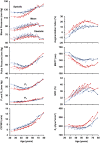Longitudinal Hemodynamic Correlates of and Sex Differences in the Evolution of Blood Pressure Across the Adult Lifespan: The Framingham Heart Study
- PMID: 37318016
- PMCID: PMC10356050
- DOI: 10.1161/JAHA.122.027329
Longitudinal Hemodynamic Correlates of and Sex Differences in the Evolution of Blood Pressure Across the Adult Lifespan: The Framingham Heart Study
Abstract
Background Systolic blood pressure increases with age after midlife, particularly in women, and contributes to development of wide pulse pressure hypertension in middle-aged and older adults. Relative contributions of aortic stiffness and premature wave reflection to increases in pulse pressure remain controversial. Methods and Results We evaluated visit-specific values and change in key correlates of pulse pressure, aortic characteristic impedance, forward and backward wave amplitude, and global reflection coefficient, at 3 sequential examinations of the Framingham Generation 3 (N=4082), Omni-2 (N=410), and New Offspring Spouse (N=103) cohorts (53% women). Data were analyzed using repeated-measures linear mixed models adjusted for age, sex, and risk factor exposures. Pulse pressure increased markedly with age after midlife (age and age-squared terms, P<0.0001), particularly in women (age slope 3.1±0.2 mm Hg/decade higher in women, P<0.0001). In sex-specific models, change in pulse pressure was closely related (all P<0.0001) to baseline (6.7±0.2 and 7.3±0.2 mm Hg/SD in men and women, respectively) and change (11.8±0.1 and 11.7±0.1 mm Hg/SD) in forward wave amplitude, whereas relations with baseline (2.1±0.15 and 2.0±0.14 mm Hg/SD) and change (4.0±0.13 and 3.4±0.11 mm Hg/SD) in global reflection coefficient were weaker. Global reflection coefficient fell as aortic characteristic impedance increased (P<0.0001), consistent with the hypothesis that impedance matching reduces relative wave reflection in the arterial system. Conclusions Proximal aortic stiffening, as assessed by higher aortic characteristic impedance and larger forward wave amplitude, is strongly associated with longitudinal increase in pulse pressure, especially in women, whereas wave reflection has more modest relations.
Keywords: aging; arterial stiffness; blood pressure; pulsatile hemodynamics; sex differences.
Figures


References
-
- Franklin SS, Jacobs MJ, Wong ND, L'Italien GJ, Lapuerta P. Predominance of isolated systolic hypertension among middle‐aged and elderly US hypertensives: analysis based on National Health and Nutrition Examination Survey (NHANES) III. Hypertension. 2001;37:869–874. doi: 10.1161/01.HYP.37.3.869 - DOI - PubMed
Publication types
MeSH terms
Grants and funding
LinkOut - more resources
Full Text Sources
Medical

